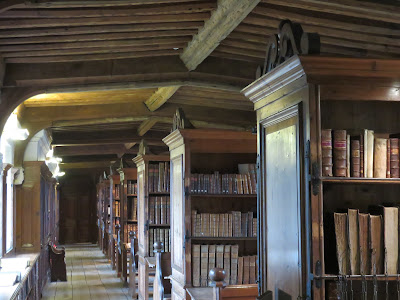On Saturday, I met up with a couple of friends to see the RSC's production of Christopher Marlowe's Tamburlaine.
It's not a play I am familiar with, I knew that it was reputed to be bloody, but that was it.
 |
| Poster in the RSC |
It is the story of Tamburlaine the Great (Jude Owusu) (loosely based on real life Turco-Mongolian conqueror Amir Timur). In the play, he starts out as a small time Scythian Shepherd / bandit, who continues upon a path of conquest and destruction, which ends badly for most of those whom he encounters.
He captures the beautiful Zenocrates (Rosy McEwen), daughter of the Soldan of Egypt, who is en route to marry the King of Arabia, and falls in love with her. His wooing takes the form of killing one of her travelling companions and conquering large parts of Persia, Africa and Turkey, as a selection of other, better established kings and emperors try, and fail, to withstand him.
He shows himself to be an immensely successful soldier and conqueror, bloody and merciless towards his defeated enemies. Which means a lot of blood... He keeps the (former) Emperor of Turkey, Bajazeth, prisoner in an iron cage, (resulting in said emperor eventually killing himself)
Later, we see Tamurlaine as emperor, continuing to conquer kingdoms, punish those who stand against him(at one point he orders the killing to a group of Vestal Virgins sent to plead on behalf of their besieged city,although in an uncharacteristic moment of compassion, he does spare the life of Zenocrates' father.!
There's a fascinating scene where Sigismond the (Christian) King of Hungary, signs a treaty with Orcanes, the (Muslim) King of Natolia, to agree to make peace in order that Orcanes can concentrate on defence against Tamburlaine.
Sigsimond bows to the advice of his generals, who convince him that vows made in the name of god but to a non-Christian should not be considered binding, breaks the treaty and attacks Orcanes' forces, whereupon he is promptly, and justly, defeated, despite his superior forces. (Orcanes, like everyone else who tries to fight Tamburlaine, is of course defeated in due course.)
 |
| View of the stage at the start of the interview |
During the interval, there was some intensive mopping of blood from the stage, and when we returned, many years have past, and Tambulaine is emperor of Persia, and he and Zencrates have 3 adult sons, the younger two being bloodthirsty fighters ,after their father's heart and the eldest, Calyphas, being more interested in poetry and girls, which results in his being killed by his father for not taking part in a battle..
In the second half , we see Tamburlaine conquer Babylon, and create a chariot drawn by a selection of the Kings he has defeated. (there's also a charming scene as he has the tongue of one of them cut out for talking back at him)
He is, however, unable to control life, and is cast into grief when Zenocrates falls ill and dies (in a demonstration of his total sanity and level-headedness, he reacts by razing to the ground the city where she died, and having her body embalmed to carry around with him. As one does.) He also becomes, if possible,even more convinced of his own power, burning his copy of the Qu'ran and deciding, when he is not truck down for this sacrilege, that he is greater than god.
Tamurlaine is defeated, not by his many enemies, but by his failing body. He names his son as his successor, and demands that he be buried with Zenocrates.
Over all, the play was interesting, if extremely bloody. I found the treatment of religion very interesting. Although Marlowe is a little confused (his Muslim characters reference 'Mahomet', as the 'friend of god, just as the Christian ones speak of christ the son of god, but also speak of various Roman gods, but for a 16th C writer seems less prejudiced than I expected! And no moral!
I'm glad I saw it.
We saw the matinee on the last day of the run, so I can't recommend you go, but it was good!





























